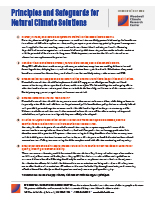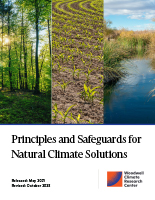Plants naturally remove carbon dioxide from the atmosphere through the process of photosynthesis, converting CO2 to carbon that is then stored in the biomass of leaves, branches, stems, roots, and soil. The carbon stored in the biomass and soils of high-carbon ecosystems can be lost quickly (e.g., through forest clearing) and take decades to centuries to replace. Protecting high-carbon ecosystems from degradation, logging, or conversion to other land uses can avoid emissions of stored carbon and retain their capacity to remove CO2 from the atmosphere (Birdsey et al. 2023; Walker et al. 2022).
- Older forests with high carbon stocks can continue to remove CO2 from the atmosphere for many decades or centuries depending on tree species, geography, climate, and natural disturbances (Curtis and Gough 2018). It has also been shown that rates of carbon accumulation in most tree species increase continuously with tree size, such that the largest 1% of trees globally store half of the aboveground biomass (Stephenson et al. 2012; Lutz et al. 2018).
- Among the planet’s forest biomes, tropical forests store the most above-ground biomass, remove the most CO2 from the atmosphere, and include the greatest area of primary forest (Mackey et al. 2020; Pan et al. 2011; Walker et al. 2022). They also provide significant biophysical cooling in addition to the effect of removing and storing carbon (Lawrence et al. 2022). When implementing NCS strategies, avoiding the fragmentation or degradation of existing tracts of primary tropical forest and protecting the largest trees—wherever they occur—should be prioritized.
- Terrestrial wetlands (i.e. non-tidal freshwater wetlands) cover about 71 million hectares in the U.S. About half of this area is forested wetland and 23% is peatland, which contains very high carbon stocks (Kolka et al. 2018). Terrestrial wetlands are significant carbon sinks, sequestering about 55 million metric tons of carbon per year both above- and below-ground. The main threats to terrestrial wetlands have been vegetation removal, surface hardening, and drainage (U.S. EPA 2016). Despite policies in the U.S. and elsewhere designed to avoid wetland conversion, losses to development and other competing land uses still occur.
- Coastal/tidal wetlands and estuaries also store large amounts of carbon. These are extremely dynamic ecosystems since they receive large quantities of soil and organic matter from adjacent terrestrial ecosystems, storing a portion within the area and exporting some to the coastal ocean (Windham-Meyers et al. 2018). Tidal wetlands in particular are among the strongest long-term carbon sinks per unit area because carbon accumulates continuously in sediments (Chmura et al., 2003). Tidal wetlands (including mangroves) and estuaries are threatened by rising sea levels, chemical runoff from the land, and disturbances such as hurricanes and drainage for development.
- Arctic and boreal ecosystems store large quantities of carbon in soils. This carbon is vulnerable to being released to the atmosphere, due to warming temperatures and increases in natural disturbances, such as wildfire and insect outbreaks (Miner et al. 2022; Schuur et al. 2018, 2022). This is especially true in frozen soils (permafrost), which in total store twice as much carbon as is found currently in the atmosphere (Zimov et al. 2006). The circumpolar permafrost zone is warming roughly 3-4 times faster than the rest of the planet—this warming is thawing perennially frozen ground and causing the release of stored carbon as carbon dioxide and methane (Chyleck et al. 2022; Romanovsky et al. 2016; Watts et al., 2023). Wildfires are also of particular concern and degraded boreal forests may be more vulnerable to their impacts (Euskirchen et al., 2022). Human influence is increasing in some areas, and more intensive land management near communities may be needed to reduce the risk of wildfire or to suppress fires after ignition (Breen et al. 2016).
High-carbon ecosystems may also be of great value for biodiversity. For example, mangrove ecosystems store some of the highest amounts of carbon on earth, and are critical habitats for a range of marine and freshwater species (Sanderman et al. 2018). Biodiversity helps sustain ecosystem services by supporting their health and resilience, which enables them to resist or quickly recover from disturbances (Seddon et al. 2021).
Improving land management
Improving land management has large global potential for increasing carbon sequestration and can be applied broadly where management intensity is high, including across tropical and temperate regions where agriculture and forestry constitute significant land uses (Walker et al. 2022). However, the potential gains in carbon removal or reduced emissions from improved land management tend to be smaller on a unit-area basis than gains from activities that protect ecosystems (Fargione et al. 2018; National Academy of Sciences 2018). With small emission reductions per unit area, a larger total area of intervention is required to achieve net emission reductions equivalent to those of an activity that has a larger impact per unit area (Birdsey 2021).
Many strategies exist for improving land management (Figure 2). Some of the more promising ones include accelerating regeneration of forests after disturbance or harvest, increasing the productivity of degraded forests through stocking enhancement, extending rotation lengths (harvest intervals) of commercial forests, improving grazing land management, organic matter amendment on croplands, improving annual cropping systems (numerous options exist), and biochar (Bossio et al. 2020; Cook-Patton et al. 2021; National Academy of Sciences 2018). Reducing the risk of wildfire is also of global concern, though how to approach that without increasing emissions from fuel reduction treatments is a challenge. In tropical regions, some forests—such as those occupying floodplains—may never recover from fire events, suggesting that fire suppression may be an effective treatment (Garcia et al. 2021). In temperate forests, there is a general consensus that in many areas, thinning from below followed by periodic prescribed burns can be effective at both reducing emissions and restoring ecosystems (Prichard et al. 2021). In boreal zones, fire management may also be a cost-effective way to limit emissions (Elder et al. 2022; Phillips et al. 2022).
Many land management strategies have the potential to be implemented at lower cost than other natural climate solutions (Cook-Patton et al. 2021). Yet, there are significant barriers to widespread deployment of improved land management practices, such as the relatively low rate of additional carbon storage (mentioned above), the need to motivate millions of landowners/managers, inadequate monitoring capacity, and evolving carbon markets and registries (National Academy of Sciences 2018).








